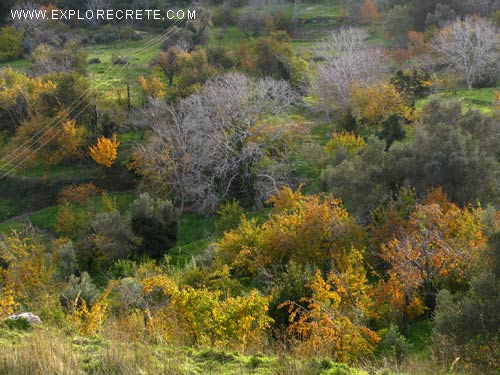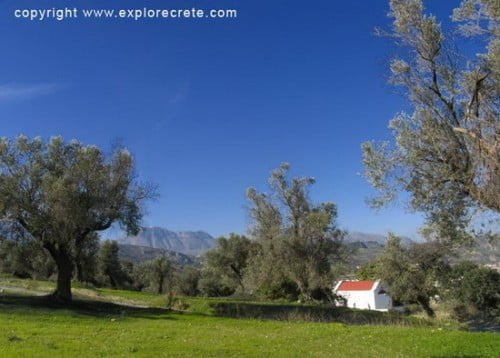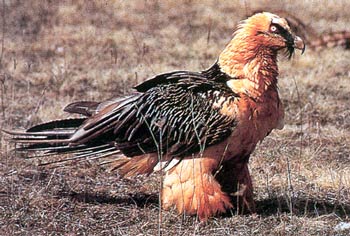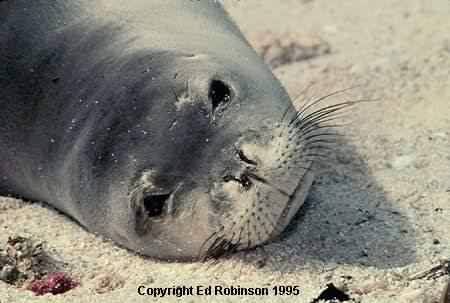Crete Sky in Winter, November and December
Crete Sky in November and December
Now that the autumn has showed us a lot of beautiful constellations and planets, the winter months November and December are here with some interesting bright objects. In these months there are some holidays, so this means more observing time! Let us start with the Constellation Cassiopeia.
Queen Cassiopeia harbours 5 bright stars in a W shape. The names of the two brightest stars are Alpha Shedir and Beta Caph. It’s high up in the north and fully embedded in the Milky Way.
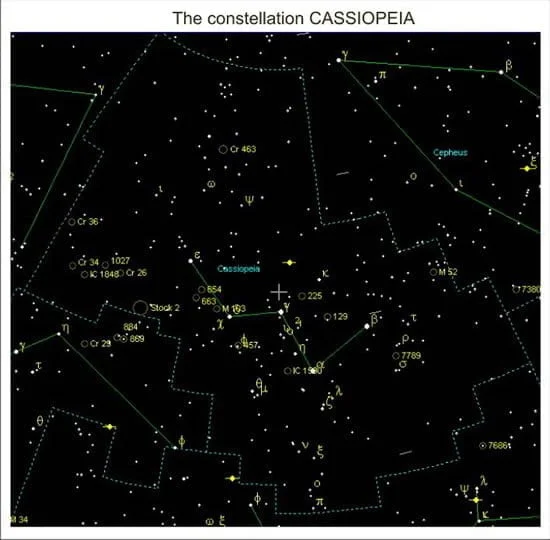
The brightest objects in Cassiopeia are NGC 663 and M52. Both are open clusters, NGC 663 has a size of 16’ with a magnitude of 7.1.

M52 has a size of 12’ with a magnitude of 6.9 and a distance of 5,000 light-years! In a very dark sky, both are visible with the naked eye as a hazy patch. Those who have binoculars can search for the individual stars in the groups.
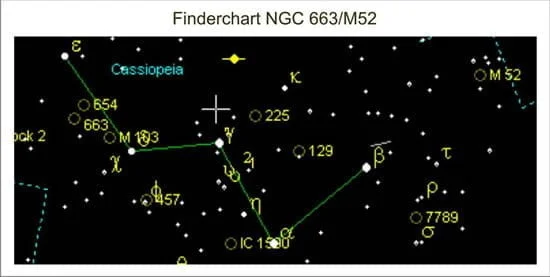
When we travel south we encounter Princess Andromeda in the constellation Andromeda. The constellation star And. Alpha is shared by two constellations, Andromeda and Pegasus. The names of the brightest stars are Alpha Alpheratz, Beta Mirach and Gamma Almach. As we stay in royal company, the constellation provides us with the best galaxy in the northern hemisphere that we can observe with the naked eye.
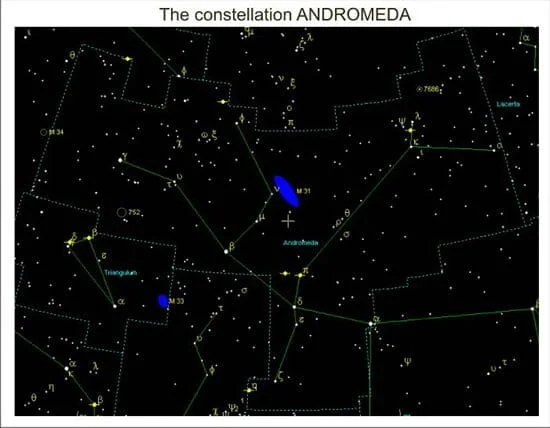
M31 is a member of the local group of galaxies just like our own galaxy. M31 can reach 3° of field when viewed with binoculars. With the naked eye you can see a misty patch, hard to focus on, with a weak, dense core. Just imagine that you are looking 2.3 million light-years away, this means that the light started its journey around 2.3 million years ago!

For those with binoculars, try to find the two satellite galaxies M32 and M110. These two systems move around M31 and they are a challenge to find.
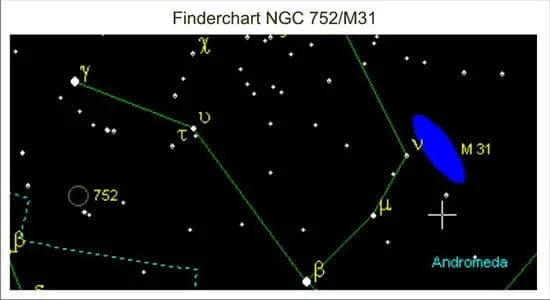
There’s one visible open cluster, NGC 752, with a magnitude of 5.7 and size of 49’. There are 60 members but don’t expect to see them al! The group is faintly visible as a dense misty patch 1,300 light-years away. Binoculars and small telescopes will give you a fantastic view filled with stars.

To the south we find the small constellation Triangulum or Triangle, the shape is formed of three 3-4 magnitude stars. Its harbours one object of interest to the naked eye. The Pinwheel Galaxy or M33 is a face-on spiral of magnitude 6.3 and size 63’x38’. Because it covers a wide area, you need a very dark sky to find it. Once you find its location, you will see a diffuse patch with no bright core, 2.7 million light-years away. If you want to see the spiral structure and features you need a big telescope, so don’t hesitate and come and take a look through our 20” cannon!

The zodiac constellation Aries or the Ram is just under the Triangle. There are no objects of interest to the naked eye. The names of the two brightest stars are Alpha Hamal and Beta Sheraton. The Moon will move through Aries on 11/12 November and 9/10 December

For the next constellation we dive into the south sea and encounter the sea monster. The constellation is Cetus, it’s a very long elongated area. The names of the brightest stars are Alpha Menkar and Beta Deneb Kaitos. There are no objects of interest to the naked eye.
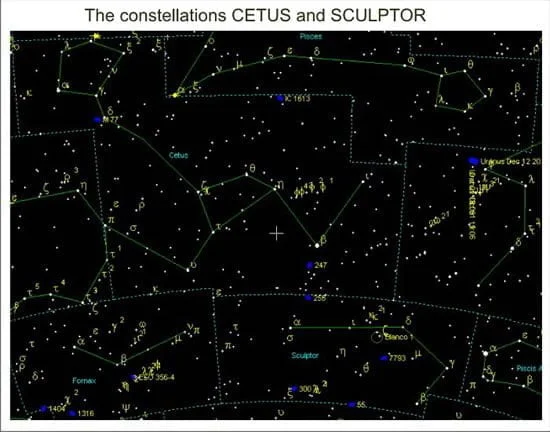
The constellation Sculptor, short for Sculptor’s Workshop, is small and difficult to find. To find Sculptor look for five stars between magnitude 4 and 5, they curve to the southwest.
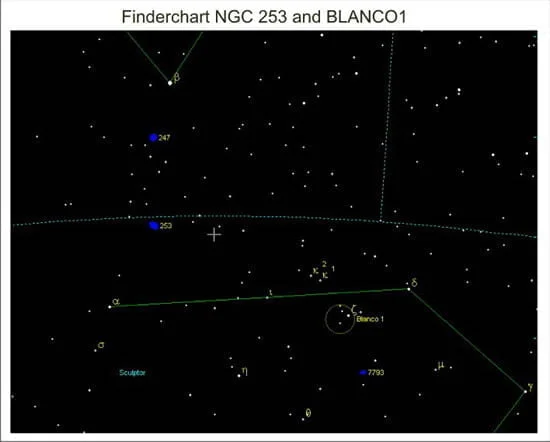

The open cluster Blanco1 is visible to the naked eye; it harbours 200 members and with binoculars we can see the brightest diamonds in a V-shape. With the naked eye you can spot the cluster core as a faint patch in a dark sky at a distance of 880 light-years.

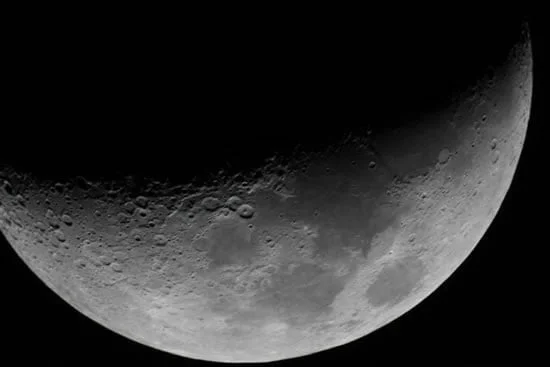
Saturn’s diameter on the equator is 120,000 kilometres and one day takes about 10 h 25’. An orbit around the Sun takes 29.5 years and the distance from the Sun is almost 1.5 billion kilometres. Venus is rising very fast now in the west before sunset. This inner planet will show phases just like the moon. Look through a telescope and see how the disk changes in the months to come.

Mercury is visible low in the east before sunrise until 8 November. Great balls of fire, if you see a bright, slow-moving meteor in November, it’s probably from the Taurid meteor shower which lasts for many weeks. (Constellation Taurus ) The radiant of the meteor shower is near the Pleiades (M45) high in the sky. The radiant is the point in the sky where the meteors enter our atmosphere.

I wish you much pleasure in watching the winter night sky for the months November and December.
Greetings,
Filip Feys
- The night sky of Crete in summer
- The sky of Crete in autumn
- The sky of Crete in winter in November and December
- The sky of Crete in winter in January and February
- Greek words for stars, zodiac signs and planets
© explorecrete.com All Rights Reserved. Reproduction or copying without permission is prohibited.

